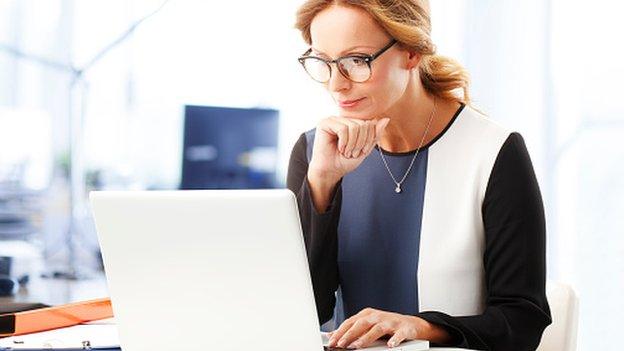Extra free childcare: Who will benefit?
- Published

Free childcare is being extended
Any working parent will tell you the cost of childcare burns a massive hole in the family wallet.
So to many, the prospect of a free 30-hours-a-week will sound like a fantastic offer.
But when the government, in other words the taxpayer, is footing the bill for a policy, there are other questions.
Such as what does it expect to get back from spending the money, other than a lot of grateful parents?
In this case, we are not starting with a blank sheet.
All three and four-year-olds in England are already entitled to the equivalent of 15 free hours a week in term time.
So we might expect in these times of tighter public spending that a detailed evaluation is under way by the Treasury.
If so, it is being conducted in such secrecy that they couldn't share the information with the Lords Select Committee on Affordable Childcare.
They weren't able to persuade a Treasury minister or official to give evidence to their recent inquiry.
As the committee said in its final report, external in February: "No hierarchy of policy objectives was provided in the written evidence from HM Treasury."
In other words, it is not clear exactly what increasing free childcare is expected to deliver.
Women working
In the past, ministers have suggested that making childcare more financially accessible would encourage a greater number of women into the labour market.
Whatever you think of this as a broader societal benefit, it does have potential gains in terms of tax revenues and potentially reducing the lifelong income gap between men and women.

Will the changes mean more women in employment?
But the effect seems to be very modest, according to the academics who have done the most comprehensive review, external of the impact of the free 15 hours for all three and four-year-olds.
Dr Claire Crawford, research fellow at the independent Institute for Fiscal Studies, described the impact as "reasonably small".
"We found that around two percentage points more women were in work compared with before the scheme. That's the equivalent of about 12,000 more women in work," she said.
When they looked more closely, it seemed that was because many three and four-year-olds were already in some kind of childcare.
So the cost of around £1.9bn a year largely delivered a cash benefit to working mothers.
But what about the children?
Learning and playing in a safe environment with other children can help develop social skills that are useful for beginning school.
Attainment gap
There is evidence that for children from poorer backgrounds, high-quality childcare can help narrow an attainment gap that will otherwise limit their life chances.
Quality, of course, can be defined in many different ways.
For the very smallest children, having kind, patient, caring staff who can give them attention is a good start.
But among academics, there is a consensus that quality means qualified.
Private and voluntary nursery and pre-school settings are considerably less likely to employ a graduate with early years training because of the cost.

The use of childcare in England:
There were 1.9 million children, under the age of five, receiving some form of childcare or early education during term time in England in 2012. Of those, 1.6 million received formal provision.
Use of childcare is particularly high among three to four-year-olds, of whom 88% (1.18 million) received formal childcare or early education in 2012, compared with 37% (429,570) of nought to two-year-olds.
As at September 2013, there were more than 25,000 nurseries and pre-schools, providing education and care to more than one million children aged nought to five; 54,000 childminders cared for a further 270,000. Added to this, 290,000 three-year-olds and 45,000 two-year-olds received education and care in maintained schools.

During the election campaign, Save the Children pointed out that two in five private or not-for-profit nurseries don't have a graduate on their staff.
So expanding hours alone won't help close that gap for children early in life.
Which brings us back to the 30 hours being offered to all three and four-year-olds where both parents are in work.
There is an opportunity for the government to drive up standards by insisting that only those places rated good or outstanding can provide the extra hours.
There is a challenge too, with many in the pre-school sector saying they are already cross-subsidising the free hours by charging more for younger children or the remaining hours.
It is an argument the government has accepted to the extent of promising an increase in the average rate.
By how much could be crucial to getting enough pre-school providers to take part in the extended scheme.
- Published1 June 2015
